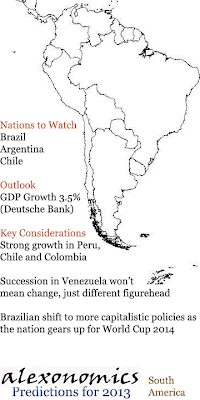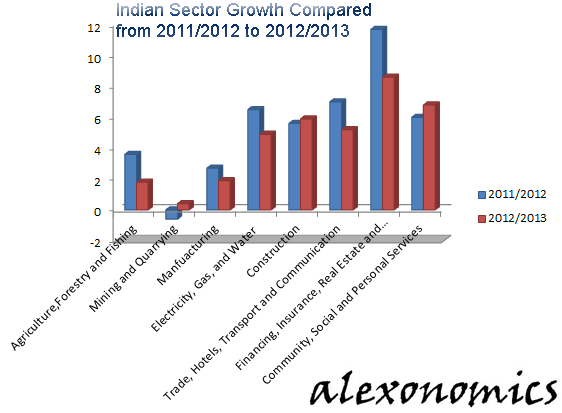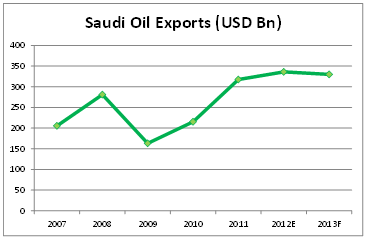Some of the same words used by
this blog to describe the Middle East can be used to describe the United States of America. Incessant wrangling would certainly be a well fitting pair of words to describe the American Congress at this point in time.

The United States has the
largest economy in the world, its GDP more than double that of the second place China. Compared to January, the unemployment rate has fallen from 7.9 to 7.6, while the average hourly earnings have increased from
23.78 to 24.01, as reported by the American Bureau of Labour Statistics. Positive news has been reported lately, specifically in the corporate world. After tax corporate earnings were almost
$2 trillion in 2012 led by ExxonMobil, Apple and Chevron. In addition, the banking and housing industries have both rebounded as home sales went to levels not seen since 2006 while bank failures have dropped to 51 in 2012 which is a third of what it was in 2010. An opinion piece in the
Telegraph recently stated the US economy has soared, which should continue as the US is home to
47% of innovators. This trend should continue as the United States is home to 19 of the world's top 25 Universities, and despite demographic worries, Wells Fargo states that the US will have its percentage of young working people at 42% between 2000 and 2050 compared to China, Europe and Japanese declines anywhere between 10% and 40%. In addition, only 25.4% of Americans will be 60 or older by 2040, lower than projections in Germany, China, and Japan.
In addition to this, the United States is on the road to energy independence through the extraction of natural gas, now the world's largest producer. The natural gas explosion has been fuelled through the chemical process of fracking, which is an unconventional form of extraction. Basically, natural gas is trapped by pumping fluid into a wellbore causing shale rock strata to create a crack, or fracture. The crack seals and traps the gas for easier extraction as the oil and gas flows to the surface.

Although the fracking industry is estimated to hold around 1.7 million jobs and projected to create a million more, there is a serious debate on whether the activity should be allowed. Fracking began with the the passage of legislation known as the Halliburton Loophole, which exempted hydraulic fracking from any regulatory supervision by the EPA under the
Safe Drinking Water Act. This was a result of Dick Cheney, who used to work at Halliburton, being appointed to the Energy Task Force and lobbying for lessened regulation on the industry. This law was passed in 2005, even after a 2004 EPA report stated
"fracturing fluids may pose a threat to drinking water long after drilling operations are completed".
The anti-fracking crowd's concerns should not be ignored. Water is essential to fracking, as one well uses around 3 to 8 million gallons of water during the lifetime of the well. Besides the heavy water usage, toxic chemicals such as antifreeze, hydraulic acid, are pumped underground and as some anti-fracking groups claim - leak into the water supply. These claims are heavily disputed by natural gas producers. The fluid that is pumped into the ground is isolated by steel and concrete from the earth, as well as the fracking takes place well below groundwater as the
fracking takes place 2500-3000 meters below the surface compared to groundwater - which is 300 meters at most below the surface.
Most problematic about fracking is the massive amount of water used. Of the water used, only 60% can be used again for fracking fluid, and eventually is too polluted to use at all. Additionally, a report released by the Democrat party stated that 750 chemicals used in the process, 29 are carcinogens while an amount of fracking fluid remains in the ground after the
well is abandoned.
 |
| This is what the anti-fracking groups claim occurs. |
However, Mr. Obama has never fully addressed his issue, echoing supporter's of fracking sentiments that there is 100 years worth of shale gas ready for exploitation.
This statement most likely is not true, as the gas wells requiring the least capital have already been exploited and to extract the remaining reserves most likely will cost more than its worth. This is exemplified by Chesapeake which has been borrowing to fund its rather unprofitable ventures.
Wall Street begs to differ. Oil production in the US hasn't been this high since 1992, and has reduced reliance on OPEC as the United States has cut their oil imports by 37% from January 2008.
Ed Morse, global head of commodities research at Citigroup stated that OPEC will find its survival challenging with the US competition.
With the heat of the debate increasing, the topic of fracking will continue to make headlines over the next year as the United States battles between energy independence and potential pollution of their water supply.
Although Americans are
slowly recovering from the recession, many are not happy about their gridlocked political situation. The Republicans and Democrats simply refuse to work together, causing the markets to react sternly in the form of debt downgrades. This issue has been widely talked about not just on this blog, but on many different media outlets. For America to begin to have a functioning government, the Republicans and Democrats must find common ground and learn to compromise for the betterment of the United States, not their own political party ambitions. Already, New Jersey governor Chris Christie has recognized this fact and has begun to offer an olive branch to the other side. Hopefully, this mentality will be copied or else America will continue to rack up budget deficits while increasing their $16 trillion debt.
 |
Finance Minister Flaherty of Canada is looking
towards a balanced budget by 2015. |
Contrarily, America's neighbours to the north have had better success in debt management, at least federally. Finance Minister Jim Flaherty has a plan to balance the budget by 2015, and so far looks on path to complete the goal. Thus far, Canada has been looked at by the rest of the world as a model for keeping a strong economic course during the global recession spurred by the financial crisis in 2008/2009. Comparatively, Canadian economic confidence is higher than the Americans and British according to an Angus
Reid Opinion poll. The
Royal Bank of Canada (RBC) has raised their estimate of Canadian growth outlook to 1.9% for 2013 and 2.9% in 2014 thanks to the improvement of corporate balance sheets along with stronger trade. This is in agreement with the
IMF, which has upgraded Canadian growth to 1.7% in 2013, but states 2014 growth will be 2.2%, well under the RBC forecast.
However, problems still lie on the horizon for the Canadian economy. It was only in April that many more negative indicators reared their ugly heads, as Statistics Canada reported that building permits for residential construction fell by 7.2% along with slow job creation and predicted higher
unemployment. It was only in January that former Bank Of Canada governor Mark Carney admitted along with Prime Minister Stephen Harper that government economic forecasts were
too rosy. The blame was placed on slow global economic growth along with a cooling housing market. Additionally, Scandinavian countries replaced Canada as the model for growth along with
Australia and New Zealand.
Mr. Stephen Poloz, the new Bank of Canada governor stated that Canada had four economic hurdles in their recent
report. First, stronger American private demand such as the recovery in the American housing market which could create stronger residential investment and higher interest rates, which may force Canada to reciprocate by raising their own interest rates. In addition to external threats, slow BRIC growth in nations such as China and Brazil will have an influence to Canada, most likely through weaker export sales and lower commodity prices. Europe most likely will continue to struggle economically, as the largest threat is contagion to the financial markets spreading. Physically, Canada's risk to European debt is little, but theoretically the risk of fear spreading could cause great damage in borrowing markets. Lastly, domestic debt continues to remain high. Although lower than previous years, Canadian household debt continues to be a problem that risks the Canadian Me\economy.
One economic event that shall be watched is the Keystone XL pipeline, which TransCanada Corp's CEO Russ Girling stated that it is unlikely construction will begin by 2015 as the company awaits a decision from the
US government. The pipeline is expected to cost around $5.3 billion and take two years to build.
Politically, Canada is relatively stable under the Conservative government led by Stephen Harper. Elections will not occur until 2015. Although some scandals have occurred and questions raised about different expenditures such as the F-35, the conservative government of Canada has set a relatively steady course rejecting rash decisions and focusing on slow thoughtful decisions. Politically, Canada is almost the opposite of the US as the majority government makes decisions that can be implemented. Although the liberals led under the popular Justin Trudeau and NDP argue differently, they will have to wait until 2015 to prove differently.
To the south of the United States lies Mexico, a country grappling with not fulfilling expected growth rates. GDP grew .8% in the first quarter of 2013, less than the 1.1% analyst estimate.
Home building has fallen in Mexico while Mexican public companies reported less than expected sales in the first quarter of 2013. Although the OECD reported at the end of 2012 that the Mexican economy will grow 3.3% in 2013
slowing from 2012's growth of 3.8%, politics may prevent this.
 |
| Can Mexico enforce reform? |
While American internal growth may hurt Mexican exports to the United States, President Enrique Pena Nieto has attempted to earn favour with the Obama administration by putting through legislation that would increase bank lending and
competitive behaviour. This may be tough, as Mr. Pena's own ruling party is not exempt from mischievous action. Additionally, Mr. Pena plans on reforming telecommunications, education, and energy; industries that will oppose any sort of change. Exemplifying this is the PRI oil workers union, which means Mr. Pena will come within confrontation of his own party. Mexico long has had problems with governmental corruption and badly needed reform. The question is how possible the reform will actually be when it comes to implementation.
In central America, many analysts are calling Panama
the Singapore of the Americas. With the IMF expecting growth averaged out around 6% over 5 years, it is known how large a part the originally American built canal is playing in the growth of Panama.
However, the Panama government's business friendly rules have created foreign investment worth around 9% of total GDP. An expansion worth $6 billion of the canal will be complete in 2014. However, wealth does not solve problems. Education and average income of many aboriginal populations both remain low. Additionally, President Martinelli has been accused of meddling with the courts while asking for American help in spying on democratic opponents. The most problematic hazard of Panama is that the Panama Canal Authority could be nationalized for cash, as cautioned by the story of Pemex in Mexico.
This blog has only mentioned four countries, and could mention other nations such as Cuba or Nicaragua. However, due to the fact that this is a continental report, the more outstanding nations in each continent are mentioned. Below, the following should be looked at in the future within the boundaries of North America:
- American political gridlock will have to end for the United States to have a successful existence. The country is not in as bad financial shape as many have suggested, but the continual disregard for compromise by both Republicans and Democrats could prove to be detrimental.
- The Keystone XL pipeline will become an increasingly important issue as Canada looks to extend their energy outlook.
- With regards to fracking, it will become a more debated topic not just in America and Canada, but across the world. The question of whether the environmental challenges that may occur because of hydraulic fracking are worth extraction of natural gas to achieve energy independence by the United States will become one of the larger questions America asks in the future.
- Panama will extend their canal successfully and become a more important nation in international commerce as continual cross ocean trade continues.

North America will continue to lead the world in both innovation and economic growth, but only if the United States' government decides to create a bipartisan relationship between the Republicans and Democrats. It is hopeful this occurs, as no other country is prepared to take over the role of global hegemony from the United States.
































